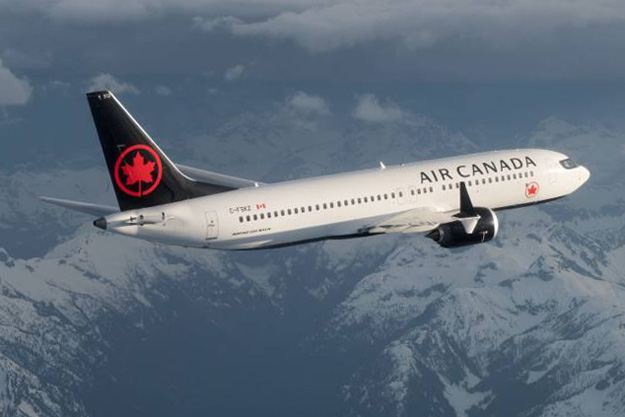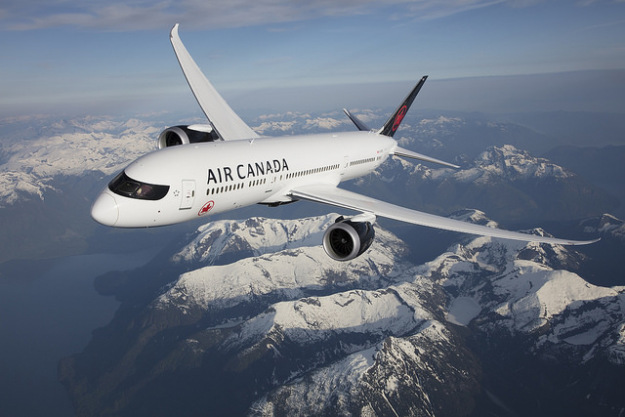
airBaltic extends operating season of flights to Athens and Keflavik
July 28, 2019
Lufthansa Group achieves an adjusted EBIT of EUR 754 million in the second quarter
July 30, 2019Air Canada today reported second quarter 2019 EBITDA(1) (earnings before interest, taxes, depreciation, amortization and impairment) of $916 million compared to second quarter 2018 EBITDA of $739 million. The airline reported second quarter 2019 operating income of $422 millioncompared to second quarter 2018 operating income of $308 million. Air Canada reported adjusted net income(1) of $240 million or $0.88 per diluted share in the second quarter of 2019 compared to adjusted net income of $129 million or $0.47 per diluted share in the second quarter of 2018. Second quarter 2019 net income amounted to $343 million or $1.26 per diluted share compared to a second quarter 2018 net loss of $102 millionor $0.37 per diluted share. The second quarter of 2019 included foreign exchange gains of $117 million while the second quarter of 2018 included a loss on disposal of assets of $186 million and foreign exchange losses of $82 million.
“I am delighted to report an excellent second quarter, including record operating revenues of $4.757 billion and record liquidity of nearly $7 billion. Although our results exceeded expectations, the Boeing 737 MAX grounding negatively impacted EBITDA growth year-over-year. Our management team and all employees involved with this complex issue did an incredible job implementing creative solutions for our fleet, schedule, network and operations to get passengers to their destinations during the quarter,” said Calin Rovinescu, President and Chief Executive Officer of Air Canada.
“These are impressive results with revenue growth in each market segment and system passenger revenues up 10.7 per cent on capacity growth of 2.3 per cent. We also managed costs well, especially with the challenges of sourcing replacement flying for some of the Boeing 737 MAX aircraft that are out of service. We have now exceeded our CTP cost savings goal of $250 million and reduced our leverage ratio to 0.9 from 1.2 in the previous quarter. On June 27th, we announced that we had concluded a definitive agreement to acquire Transat A.T. Inc. which, we believe, once closed, will benefit all stakeholders. Already, the merger’s benefits have been recognized by key stakeholders, including Unifor, Aéroports de Montréal, Tourism Montréal, leading travel agencies, the Chamber of Commerce of Metropolitan Montreal, the Conseil du patronat du Québec and the Federation of Chambers of Commerce of Québec.

“The impact of the Boeing 737 MAX grounding will be felt more acutely in our very busy summer period and, as a result, third quarter EBITDA is expected to increase approximately five per cent versus the third quarter of 2018. Third quarter projected capacity is expected to decline approximately two per cent compared to the third quarter of 2018, as opposed to an originally planned capacity increase of approximately three per cent. In our planning, we will be removing the Boeing 737 MAX from our schedule until at least January 8th, 2020. This reflects our prudent approach to scheduling, giving customers certainty when booking their Fall and especially their Winter holiday travel. At present, we have no visibility on reliable timing for the return to service of the Boeing 737 MAX as we await regulatory approvals. If the aircraft are returned to service earlier, we would look for opportunities to have some enter the fleet for either replacement flying or as back-ups,” said Mr. Rovinescu.
“Finally, I thank our customers for their loyalty, which they also showed by voting Air Canada Best Airline in North America at the 2019 Skytrax World Airline Awards. This award, which we have won for three consecutive years, speaks directly to the hard work of our employees, who also won Best Airline Staff in Canada from Skytrax. I thank our employees for their dedication to caring for our customers as they transport them safely to their destinations each day.”
Second Quarter Income Statement Highlights
Air Canada began consolidating Aeroplan’s financial results on January 10, 2019, the date of its acquisition of Aeroplan. Air Canada adopted accounting standard IFRS 16 – Leases effective January 1, 2019 and restated 2018 amounts (including for period-over-period comparisons).
On capacity growth of 2.3 per cent, record second quarter system passenger revenues of $4.338 billion increased $417 million or 10.7 per cent from the same quarter in 2018. The increase in system passenger revenues was driven by a yield improvement of 6.8 per cent and traffic growth of 3.6 per cent. The yield improvement reflected incremental higher-yielding local traffic due to the impact of constrained capacity caused by the grounding of the Boeing 737 MAX aircraft and a generally improved pricing environment. The yield increase year-over-year also reflected additional yield earned by Air Canada on Aeroplan redemption revenues which Air Canada began recording subsequent to the Aeroplan acquisition on January 10, 2019. In the second quarter of 2019, EBITDA was negatively impacted by the Boeing 737 MAX grounding, despite the positive yield effect.
In the business cabin, system passenger revenues increased $83 million or 10.2 per cent from the second quarter of 2018 on both traffic and yield growth of 5.0 per cent.
In the second quarter of 2019, operating expenses of $4.335 billion increased $310 million or 8 per cent from the second quarter of 2018.
Air Canada’s cost per available seat mile (CASM) increased 5.2 per cent from the second quarter of 2018. The airline’s adjusted CASM(1) increased 5.9 per cent over the same quarter in 2018. These increases reflected, in large part, the impact of the Boeing 737 MAX aircraft grounding which resulted in ASM growth of less than half of what had originally been planned, higher costs associated with replacement aircraft, and on-going operating expenses, including depreciation and
pilot wages that continued to be incurred in relation to the Boeing 737 aircraft despite their grounding. Air Canada had 24 Boeing 737 MAX aircraft in its operating fleet at the time of the grounding and was expecting to receive another 12 aircraft for a total fleet of 36 Boeing 737 MAX aircraft by July 2019. Given that the Aeroplan loyalty business was not consolidated in Air Canada’s financial results in 2018, for a more meaningful comparison of the cost performance of the on-going airline business, Air Canada’s adjusted CASM for the second quarter of 2019 excludes the operating expenses of Aeroplan.
Financial and Capital Management Highlights
At June 30, 2019, unrestricted liquidity (cash, cash equivalents, short-term investments and undrawn lines of credit) amounted to a record $6.907 billion (June 30, 2018 – $5.064 billion).
At June 30, 2019, net debt of $3.277 billion decreased $1.937 billion from December 31, 2018, reflecting an increase in cash, cash equivalents and short-term and long-term investment balances of $1.467 billion and a decrease in long-term debt and lease liabilities of $470 million. At June 30, 2019, Air Canada’s leverage ratio was 0.9 versus a ratio of 1.6 at December 31, 2018.
Net cash flows from operating activities of $1.090 billion increased $9 million compared to the second quarter of 2018. In the second quarter of 2019, free cash flow(1) of $537 million increased $413 million from the second quarter of 2018, mainly due to a lower level of capital expenditures year-over-year, in large part due to the deferral of Boeing 737 MAX aircraft deliveries.
For the 12 months ended June 30, 2019, return on invested capital (ROIC(1)) was 15.5 per cent, significantly higher than Air Canada’s weighted average cost of capital of 7.2 per cent. In the second quarter of 2019, Air Canada changed its definition of excess cash. Air Canada defines excess cash as total cash and investments in excess of the minimum cash required to support operations. This measure of liquidity includes cash, cash equivalents, short-term investments, short-term restricted cash and long-term investments. Air Canada now uses 20 per cent of trailing 12 months operating revenue as its estimate of the minimum cash required to support on-going business operations. This estimate of minimum cash provides adequate coverage for advance ticket sales and to meet Air Canada’s liquidity needs. Previously, Air Canada used advance ticket sales and the current portion of Aeroplan and other deferred revenue as an estimate of its cash requirements.
Normal Course Issuer Bid
In the second quarter of 2019, Air Canada purchased, for cancellation, a total of 2,770,000 shares at an average cost of $38.83 per share for aggregate consideration of $108 million (a total of 4,314,487 shares at an average cost of $36.77 per share for aggregate consideration of $159 million in the first six months of 2019). At June 30, 2019, a total of 22,645,551 shares remained available for purchase under the existing normal course issuer bid.
In the second quarter of 2018, Air Canada purchased, for cancellation, a total of 859,565 shares at an average cost of $24.92 per share for aggregate consideration of $22 million (914,218 shares at an average cost of $24.78per share for aggregate consideration of $23 million for the six months ended June 30, 2018).
Outlook
Because the timeline for the return to service of the Boeing 737 MAX aircraft remains uncertain, for planning purposes, Air Canada is removing Boeing 737 MAX flying from its schedule until at least January 8th, 2020. Final decisions on returning the Boeing 737 MAX aircraft to service will be based on Air Canada’s safety assessment following the lifting of government safety notices and approval by international regulatory authorities. Air Canada’s projected capital expenditures, which can be found in section 6.6 of Air Canada’s Second Quarter 2019 Management’s Discussion and Analysis of Results, has been updated to reflect its assumption that the remaining 12 Boeing 737 MAX aircraft deliveries scheduled for 2019 will now be delivered in 2020.
Air Canada announced in its March 15, 2019 news release that it was suspending the financial guidance it provided on February 15, 2019 and February 28, 2019 in respect of the 2019 financial year, given the grounding of the Boeing 737 MAX aircraft until further notice and Boeing’s decision to suspend 737 MAX deliveries to airline customers.
The financial guidance provided for the years 2020 and 2021 with respect to annual EBITDA margin (earnings before interest, taxes, depreciation, amortization and impairment, as a percentage of operating revenue) and annual ROIC, as well as the cumulative free cash flow over the 2019-2021 period, remains in place.
Major Assumptions: Assumptions were made by Air Canada in preparing and making forward-looking statements. As part of its assumptions, Air Canada assumes relatively modest Canadian GDP growth for the third quarter and full year 2019. Air Canada also expects that the Canadian dollar will trade, on average, at C$1.31 per U.S. dollar in the third quarter and at C$1.32 per U.S. dollar for the full year 2019 and that the price of jet fuel will average 78 CAD cents per litre in the third quarter and the full year 2019.
Outlook provided constitutes forward-looking statements within the meaning of applicable securities laws and is based on a number of assumptions (including those provided above) and subject to a number of risks. Please see the section below entitled “Caution Regarding Forward-Looking Information”.
(1) Non-GAAP Measures
Below is a description of certain non-GAAP measures used by Air Canada in an effort to provide readers with additional information on its financial and operating performance. Such measures are not recognized measures for financial statement presentation under GAAP, do not have standardized meanings, may not be comparable to similar measures presented by other entities and should not be considered a substitute for, or superior to, GAAP results. Readers are advised to review the section entitled Non-GAAP Financial Measures in Air Canada’s Second Quarter 2019 MD&A for a further discussion of such non-GAAP measures and a reconciliation of such measures to Canadian GAAP.
- Adjusted net income (loss) and adjusted earnings (loss) per share – diluted are used by Air Canada as a means to assess the overall financial performance of its business without the after-tax effects of foreign exchange gains or losses, net financing expense relating to employee benefits, gains or losses on financial instruments recorded at fair value, gains or losses on sale and leaseback of assets, gains or losses on debt settlements and modifications, gains or losses on disposal of assets, and special items as these items may distort the analysis of certain business trends and render comparative analysis to other airlines less meaningful.
- Adjusted pre-tax income (loss) is used by Air Canada to assess the overall pre-tax financial performance of its business without the effects of foreign exchange gains or losses, net financing expense relating to employee benefits, gains or losses on financial instruments recorded at fair value, gains or losses on sale and leaseback of assets, gains or losses on debt settlements and modifications, gains or losses on disposal of assets, and special items as these items may distort the analysis of certain business trends and render comparative analysis to other airlines less meaningful. Air Canada uses adjusted pre-tax income (loss) before interest to determine return on invested capital.
- EBITDA (earnings before interest, taxes, depreciation, amortization and impairment) is commonly used in the airline industry and is used by Air Canada as a means to view operating results before interest, taxes, depreciation, amortization and impairment as these costs can vary significantly among airlines due to differences in the way airlines finance their aircraft and other assets. Air Canada excludes special items from EBITDA as these items may distort the analysis of certain business trends and render comparative analysis to other airlines less meaningful.
- Adjusted CASM is used by Air Canada as a means to assess the operating and cost performance of its on-going airline business without the effects of aircraft fuel expense, the cost of ground packages at Air Canada Vacations®, the operating costs of Aeroplan, and special items as such expenses may distort the analysis of certain business trends and render comparative analysis to other airlines less meaningful.
In calculating adjusted CASM, aircraft fuel expense is excluded from operating expense results as it fluctuates widely depending on many factors, including international market conditions, geopolitical events, jet fuel refining costs and Canada/U.S. currency exchange rates. Air Canada also incurs expenses related to ground packages at Air Canada Vacations which some airlines, without comparable tour operator businesses, may not incur. In addition, these costs do not generate ASMs and therefore excluding these costs from operating expense results provides for a more meaningful comparison across periods when such costs may vary.
Excluding aircraft fuel expense, the cost of ground packages at Air Canada Vacations and special items from operating expenses generally allows for a more meaningful analysis of Air Canada’s operating expense performance and a more meaningful comparison to those of other airlines.
Following the completion of Air Canada’s acquisition of Aeroplan on January 10, 2019, Air Canada began consolidating Aeroplan’s results. Given that the Aeroplan loyalty business was not consolidated in Air Canada’s financial results in 2018, for a more meaningful comparison of the cost performance of the on-going airline business, Air Canada’s adjusted CASM for 2019 excludes the operating expenses of Aeroplan.
- “Leverage ratio” refers to net debt to trailing 12-month EBITDA leverage ratio and is commonly used in the airline industry and is used by Air Canada as a means to measure financial leverage. Leverage ratio is calculated by dividing net debt by trailing 12-month EBITDA (excluding special items). As mentioned above, Air Canada excludes special items from EBITDA results (which are used to determine leverage ratio) as these items may distort the analysis of certain business trends and render comparative analysis to other airlines less meaningful.
- Free cash flow is commonly used in the airline industry and is used by Air Canada as an indicator of the financial strength and performance of its business, indicating the amount of cash Air Canada is able to generate from operations and after capital expenditures. Free cash flow is calculated as net cash flows from operating activities minus additions to property, equipment and intangible assets, and is net of proceeds from sale-leaseback transactions. Free cash flow in 2019 also excludes the one-time proceeds related to the Aeroplan acquisition.
- Return on invested capital (ROIC) is used by Air Canada as a means to assess the efficiency with which it allocates its capital to generate returns. ROIC is based on adjusted pre-tax income (loss), excluding interest expense. Invested capital includes average year-over-year long-term debt, average year-over-year lease obligations, and average year-over-year shareholders’ equity, net of excess cash. Air Canada defines excess cash as cash not required to operate its core business. Air Canada uses 20 per cent of trailing 12 months operating revenue as its estimate of the minimum cash required to support on-going business operations. This estimate of minimum cash provides adequate coverage for advance ticket sales and to meet Air Canada’s liquidity needs. Air Canada calculates invested capital based on a book value-based method of calculating ROIC, as described above. Refer to the definition of adjusted pre-tax income (loss) for a discussion as to why Air Canada uses adjusted pre-tax income (loss) to assess the overall pre-tax financial performance of its business.



